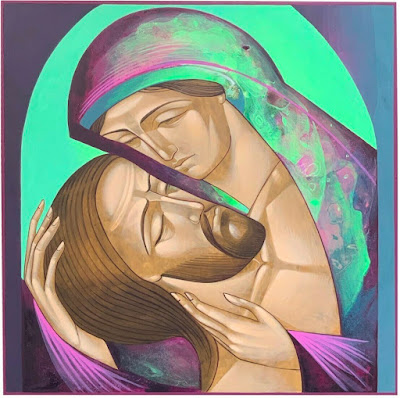Easter Sunday
Supposing
him to be the gardener …
John 20:15
Why does Mary Magdalene suppose Jesus to be the
gardener?
Is it because, through her grief, she cannot see clearly?
Or is it that because of her grief she can see more clearly than before? After
all, Jesus said, ‘Blessed are those who mourn, for they will be comforted.’ And
what greater comfort than to see Jesus as he truly is?
This year, as we have prepared to celebrate Easter, I
have taken opportunities to share with you the work of the Lviv School of
Iconographers. And this Easter morning, I would like to introduce you to
Kateryna Kuziv, an artist whose work explores the theme of the great theme of
the garden.
This first image depicts the Tree of Life, one
of two trees God planted in the middle of the garden of Eden. Kuziv depicts it
not in literal green but symbolic blue: the tree of life. This tree,
bursting with life, is cruciform.
The next image depicts the Tree of the Knowledge of
Good and Evil. This tree is also cruciform, but it introduces darkness and
light. Indeed, light is bursting out from darkness: evil makes its presence
felt but cannot contain goodness; and, in bursting free, good breaks evil
apart.
The third image is the Creation of Adam and Eve.
The gardener placed in the garden to watch over it, and the companion created as
a champion to contend for the gardener. Humanity lives in harmony with the
garden.
But the next image is simply called Trespass. Presented
to us by a Ukrainian artist in these days when Russia has trespassed onto
Ukraine, the icon takes on new layers. Yet it depicts the seemingly insatiable
appetite to consume what we gaze upon, and humanity finds itself bound, constrained
by the very knowledge we desire.
And following on from Trespass, we have Exile.
The human family, wrapped in the shrouds of death and cut off from the harmony
of creation. There is still beauty in the world, but it is spoiled by pollution,
a great stain. A great sorrow, and a deadness of spirit.
And here we move on, to the Genealogy of Jesus.
Again, we have a tree, blue for life, bursting with leaves and flowers and
fruit, and the names of Jesus’ ancestors. Abraham at the root, and Mary Mother
of God and her Son at the apex. Lives marked by deadness turned to life and
despair turned to rejoicing. All of life is here, and God is at work in and
through it.
The next image is Epitaphios, an icon of the
shroud of the dead Christ. If you look carefully, within the shroud—which is
depicted as a blue cloth, pointing to resurrection life—you will see the
imprint of Christ’s halo—symbol of holiness—and of his wounds: hands folded
across his chest, pierced side, his feet. And the flowering of the empty cross:
the cruciform tree. This moment, the death and resurrection as one piece, is
the birthing of a new creation, the planting of a new Eden. The moment of
defeat is the moment of victory.
And following on, the Appearance of Jesus Christ to
Maria Magdalena. Here is the gardener, the new Adam, the new humanity,
nowhere more tangible than in his wounds. And the new Eve, the new champion who
will contend for the gardener, who will carry the news of his resurrection to his
disciples. And here is the life of the garden, bursting out all around.
And one final image the Throne of God. Blue for
the life of heaven, and bursting with leaves, for the healing of the nations. An
invisible throne, Christ made visible in the revelation of the written Word.
‘Supposing him to be the gardener…’ And, of course,
Mary’s supposition was quite right. Jesus is the gardener, the one who faithfully
watches over the garden. The one who kept watch and prayed in the Garden of
Gethsemane while his disciples slept for grief. The one who watched over Mary,
when Simon Peter and the other disciple had gone home leaving her behind, and
who witnessed her blossoming and sent her to bear witness to his own. The One through
whom, and with whom, and in whom, all creation bursts free to worship the
Father. Who has restored in men and women the image of God’s glory, placed us
once more in paradise, and opened to us the gate of life eternal. And today, on
this Resurrection morning, he calls you by name. How will you respond?





















